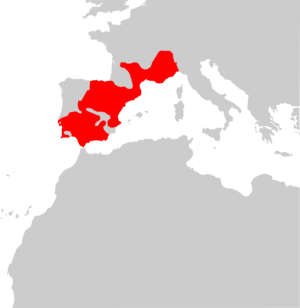Mediterranean pine vole facts for kids
Quick facts for kids Mediterranean pine vole |
|
|---|---|
| Conservation status | |
| Scientific classification | |
| Genus: |
Microtus
|
| Species: |
duodecimcostatus
|
The Mediterranean pine vole (Microtus duodecimcostatus) is a small rodent. It belongs to the family Cricetidae. You can find this animal in France, Andorra, Portugal, and Spain. It lives underground in a network of shallow tunnels.
Contents
About the Mediterranean Pine Vole
The Mediterranean pine vole is a small creature. Its head and body are about 3.5 to 4.25 inches long. Its tail is short, measuring only 0.75 to 1.75 inches. This vole weighs around 1 ounce, which is very light! It has a wide head, small ears, and medium-sized eyes. Its fur is soft and thick. The top part of its body is yellowish-grey-brown. Its belly is a bit lighter in color. Young voles look more grey than adults.
Where It Lives and Its Home
This vole lives only in the greater Iberian Peninsula. This area includes southern France, Andorra, Portugal, and most of Spain. It can live at high places, up to 2,250 meters (about 7,380 feet) above sea level. The Mediterranean pine vole is common in many parts of its home range. In some areas, there can be hundreds of voles in just one hectare (about 2.5 acres).
Unlike some other voles, its population does not change a lot. This species prefers lowland areas. It likes places where the soil is deep and light. You can find it in fields with clover, meadows, empty farmlands, and fruit orchards. Sometimes, when there are many voles, they can become a pest for farmers' crops.
Daily Life and Habits
The Mediterranean pine vole is mostly active during the day. It digs many shallow tunnels underground. As it digs, it pushes small piles of earth to the surface. It eats different kinds of plants. Its diet includes grasses, clover, alfalfa, roots, and other crop plants. It also stores food in its burrow to eat during the winter.
Life Cycle and Young
Mediterranean pine voles seem to breed all year round. The mother vole prepares a special chamber deep in her burrow system. She lines this chamber with dried plants. After about 20 days, she gives birth to a litter of up to eight young voles. These voles usually live for about two years. Some have even been recorded living for 33 months, which is a very long time for a vole!
Its Conservation Status
The IUCN (International Union for Conservation of Nature) lists the Mediterranean pine vole as "Least Concern". This means it is not currently in danger of disappearing. It is a common species, and its population is quite stable. However, a main threat to these voles comes from farmers. When farmers use pest control methods, it can cause big problems for local vole populations.



